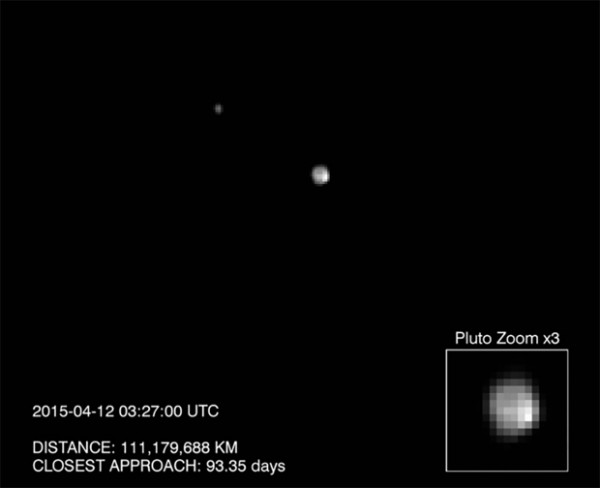Pluto May Have Polar Ice Cap, New NASA Images Reveal
| Marco Foronda | | Apr 30, 2015 02:10 AM EDT |
(Photo : NASA) An image captured by NASA's New Horizons probe showing the dwarf planet Pluto and its large moon Charon at a distance of some 70 million miles. The images are the first to show distinct surface features, including a bright area that may be an icy polar cap.
NASA says that the new images from the New Horizons probe approaching Pluto suggest it might have a polar cap of nitrogen ice
Launched in 2006, the New Horizons spacecraft, built by the Applied Physics Laboratory at Johns Hopkins University, is now just two months away from a historic flyby of the dwarf planet on July 14.
Like Us on Facebook
The observation came in a series of pixilated images taken April 12-19 as the spacecraft closed in from 69 million miles to 64 million miles. Combined into an animation, the latest views show a rotating Pluto circled by Charon, the largest of its five known moons.
Alan Stern, the New Horizons principal investigator at the Southwest Research Institute, said that Pluto’s surface features are real, allowing us to see that Pluto has very broad surface markings.
Another series of images is planned from May 8-14, and NASA is promising another movie in mid-May. Daily observations will begin May 28 with "better and better resolution."
At the 3 o'clock position on the planet, Stern said we can the image remaining on its brighter state.
"That's a pole, and that may be evidence for a polar cap, which would be very, very exciting. Whether it's actually a polar cap or not depends upon data we'll be collecting in the future, compositional data from our spectrometers, which will begin to come in when we're closer in June,” Stern added.
Hal Weaver, the mission project scientist, said even at Pluto's vast distance from the sun, very slight temperature variations can produce polar caps.
Weaver said that the polar cap is a region is usually a little bit colder than the rest of the surface and it causes volatile ices to condense on the surface
"And that's what we think we're seeing. In another month and a half, we're going to actually map the composition, so we'll be able to tell whether or not there's really ice, whether those brightest regions are really ice, snowy patches,” Weaver added.
TagsPluto May Have Polar Ice Cap New NASA Images Reveal, NASA, Pluto, Charon, Pluto Moon, Pluto Polar Ice cap, polar ice cap, dwarf planet, New Horizons, space exploration, Universe
©2015 Chinatopix All rights reserved. Do not reproduce without permission
EDITOR'S PICKS
-

Did the Trump administration just announce plans for a trade war with ‘hostile’ China and Russia?
-

US Senate passes Taiwan travel bill slammed by China
-

As Yan Sihong’s family grieves, here are other Chinese students who went missing abroad. Some have never been found
-

Beijing blasts Western critics who ‘smear China’ with the term sharp power
-

China Envoy Seeks to Defuse Tensions With U.S. as a Trade War Brews
-

Singapore's Deputy PM Provides Bitcoin Vote of Confidence Amid China's Blanket Bans
-

China warns investors over risks in overseas virtual currency trading
-

Chinese government most trustworthy: survey
-

Kashima Antlers On Course For Back-To-Back Titles
MOST POPULAR
LATEST NEWS
Zhou Yongkang: China's Former Security Chief Sentenced to Life in Prison

China's former Chief of the Ministry of Public Security, Zhou Yongkang, has been given a life sentence after he was found guilty of abusing his office, bribery and deliberately ... Full Article
TRENDING STORY

China Pork Prices Expected to Stabilize As The Supplies Recover

Elephone P9000 Smartphone is now on Sale on Amazon India

There's a Big Chance Cliffhangers Won't Still Be Resolved When Grey's Anatomy Season 13 Returns

Supreme Court Ruled on Samsung vs Apple Dispute for Patent Infringement

Microsoft Surface Pro 5 Rumors and Release Date: What is the Latest?










